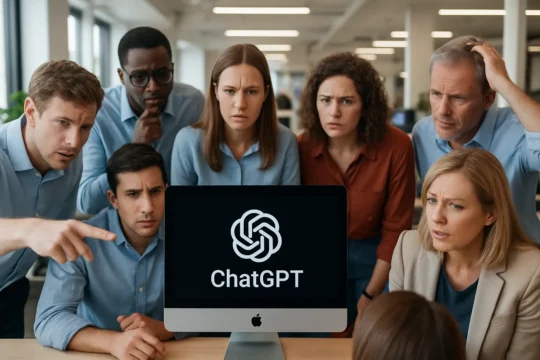How to Use ChatGPT in Your Business

Most people think of ChatGPT as a clever chatbot.
Smart business leaders see something else: a chance to radically streamline processes, spark innovation, and give their teams back precious time.
If you’re still just “trying it out,” you’re only scratching the surface.
In this guide, we’ll show you how to use ChatGPT effectively (and securely) in your organisation, including prompt-writing tips, a breakdown of free vs paid plans, and the security steps every team should take before adopting AI tools at scale.
What You’ll Learn
Quick Start: How to Use ChatGPT in Business
To use ChatGPT safely and effectively:
- Use our 4-part prompting framework: Role → Task → Context → Format
- Skip real data and always use placeholders to keep client info safe
- Choose the right plan. Plus or Team give you better controls and faster output
- Treat it like a second brain. Fact-check everything, especially legal or financial content
- Make it official. Roll out an internal AI policy so everyone stays consistent and secure
When used strategically, ChatGPT becomes more than a chatbot, it’s a productivity amplifier. It streamlines decision-making, cuts through admin noise, and helps teams focus on higher-value work. But let’s be clear: it’s not plug-and-play. Use it like any powerful enterprise tool, with clear prompts, defined purpose, and human-led oversight.
What Is ChatGPT, Really?
ChatGPT is an AI-powered assistant developed by OpenAI. At its core, it’s a conversational interface for generative AI capable of tasks like writing, summarising, analysing, and idea generation, all based on natural-language prompts.
Used right, it becomes an extension of your team: a research partner, copy assistant, spreadsheet whisperer, and sparring partner for strategy.
But it’s not magic. It requires direction, structure, and guardrails.
Which ChatGPT Plan Do You Need?
Before we dive into use cases or prompting techniques, let’s clarify what you’re actually getting:
| Plan | What You Get |
| Free | Basic access to GPT‑5, including text and voice. Experience entry-level performance with usage caps, but without image generation or advanced agents. |
| Plus | Enhanced access to GPT-5—including optimal routing between fast or deep reasoning modes, file uploads (e.g. PDFs/spreadsheets), and increased usage limits. |
| Pro | Unrestricted use of GPT-5 Pro and “GPT-5 Thinking” for superior reasoning, faster performance, and extended memory. Includes the longest context windows (up to ~256K tokens), and better integration with tools. |
| Team/Enterprise | Everything in Pro, plus centralised admin controls, enterprise-grade security, collaboration tools, extended API functionality, custom model access, and priority support. GPT-5 is available by default. |
Why this matters for your business:
- GPT-5 delivers smarter, faster, and more accurate AI assistance—automatically switching between deep thinking and quick answers.
- Even the Free tier now includes GPT-5, making premium AI capabilities more accessible.
- Upgrading unlocks significantly higher usage limits, deeper reasoning, and enhanced outputs—ideal for SME leaders who rely on clear, reliable guidance.
Learn more on OpenAI’s plan comparison
Prompting Like a Pro: Our 4-Part Formula
To get high-quality results from ChatGPT, structure is everything. At CYAN, we use a 4-part prompting framework. Below are 2 examples of how to use this framework within your business:
Objective: You’re a business leader preparing for a board meeting and need to summarise the key IT risks and upcoming investment priorities. You want a structured briefing you can share internally or use to guide discussion.
| Element | Example Prompt Snippet |
|---|---|
| Role | “You are a virtual CIO with experience supporting SMEs…” |
| Task | “…create a summary of current IT risks and future investment priorities…” |
| Context | “…for a professional services firm with 50 staff, using Microsoft 365 and no in-house IT team.” |
| Format | “…return as a short briefing with bullet points under ‘Risks’, ‘Recommendations’, and ‘Next Steps’.” |
Objective: You manage operations or logistics and need to create a clear onboarding checklist for new delivery suppliers — something structured that keeps everyone aligned.
| Element | Example Prompt Snippet |
| Role | “You are a logistics coordinator with experience in supply chain planning…” |
| Task | “…create a checklist for onboarding a new delivery supplier…” |
| Context | “…for a UK-based e-commerce business with warehousing in two locations.” |
| Format | “…return as a table with task, owner, deadline, and notes columns.” |

💡 Tip: Be specific about tone, audience, and output. You’ll get far more relevant, actionable responses the more in-depth your prompt is.
⚠️ Reality check: GPT-5 introduces a “safe completions” approach, flagging potentially inaccurate, unsafe, or unverifiable information before you use it. While it’s much more reliable than previous versions, you should still fact-check anything related to HR, finance, compliance, or legal matters. AI remains a co-pilot, not the driver.
Business Use Cases You Might Be Missing
Most teams use ChatGPT to summarise emails or write social media content. Fair. But here’s how to push further:
Strategic Planning
Use it to map out new processes, spot risks, or compare vendors using custom criteria.
Idea Sprinting
Give it a seed concept and ask for 10 taglines, 3 campaign ideas, or 5 angles for your next board pitch.
Internal Training
Create draft onboarding checklists, training scenarios, or explainers tailored to your team’s tools.
Data Wrangling
Paste spreadsheet data and ask it to clean, format, or summarise patterns. (Premium plan required.)
Takeaway:
GPT-5’s new agentic capabilities allow it to manage entire multi-step processes. For example, researching suppliers, summarising findings, drafting emails, and scheduling meetings without you lifting a finger. It can also integrate with tools, APIs, and web browsers to gather real-time data.
This makes it a far more powerful automation partner. But remember, every output still needs a human sense-check.
How to Use ChatGPT Without Leaking Confidential Data
Most AI guides stop at prompting. But security? That’s where things get real.
If your team is using ChatGPT like a casual Google doc, pasting in client data, internal messages, or sensitive contracts, it’s time to rethink your approach.
Here’s your essential safety checklist:
- Never paste customer names, emails, or sensitive contracts
- Replace identifiable data with placeholders (e.g. “Client A”)
- Turn off “Chat history & training” (available on the Plus plan)
- Use ChatGPT Team or Enterprise for anything high-risk or regulated
- Create a clear internal AI Use Policy (we’ve written one for you → check it out here)
💡Remember: ChatGPT is a third-party platform. If you’re not treating it like any other software vendor, with controls, boundaries and risk reviews, you’re taking avoidable risks.
Why You Need an AI Policy Before You Scale
If you’re experimenting with AI tools across departments, consistency matters. A written AI policy:
- Sets expectations for ethical, secure use
- Guides staff on what data is fair game
- Reduces legal and reputational risk
- Aligns AI use with your existing security strategy
We’ve created a clear, editable AI Policy Template you can adapt to your organisation.
👉 Get the free AI policy template here

TL;DR: Your ChatGPT Implementation Checklist
| Step | Action |
| 1 | Define your use cases and priority teams |
| 2 | Choose the right ChatGPT plan for data needs |
| 3 | Train staff on prompt structure and tone |
| 4 | Lock down sensitive data protocols |
| 5 | Roll out an internal AI policy |
| 6 | Review performance quarterly and refine use |
Final Thought: Use ChatGPT with Purpose
AI isn’t here to replace your team. It’s here to unlock their potential.
The businesses that win with ChatGPT (or any AI tool) aren’t using it because it’s trendy. They’re using it because they’ve thought deeply about risk, training, process and have built a structured approach that makes it a genuine advantage.
Ready to Get Strategic with AI?
We help organisations adopt AI calmly and securely. No guesswork, no hype. Speak to our team about structured, risk-aware AI adoption.
Get in touch![How Much Cyber Security Insurance Cover Do You Actually Need? [FREE Download] How Much Cyber Security Insurance Do You Need](https://cyansolutions.co.uk/wp-content/uploads/2025/07/How-Much-Cyber-Security-Insurance-Do-You-Need-600x305.webp)
